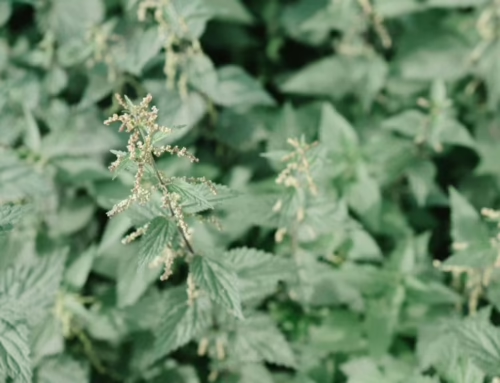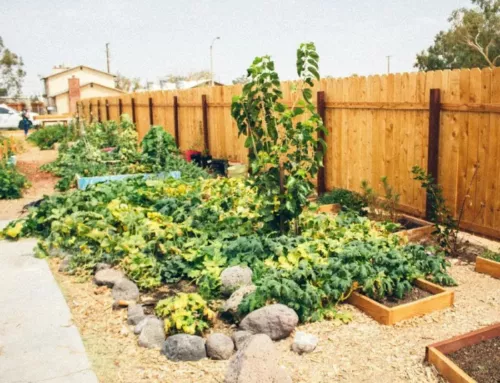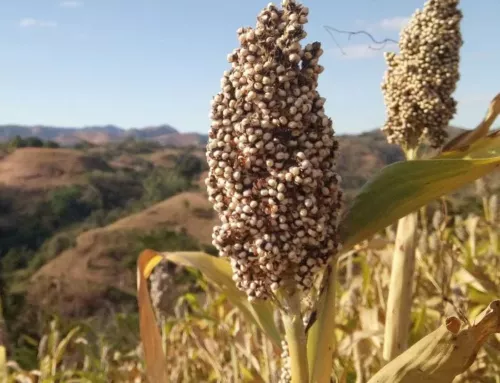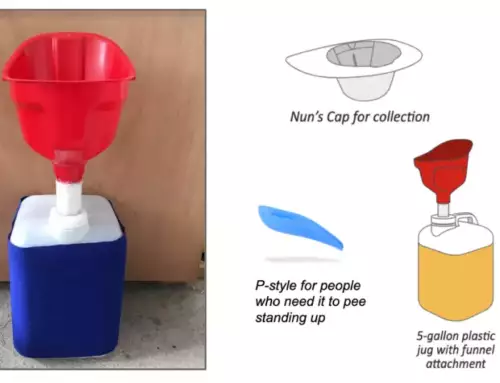By Noah Courser-Kellerman, Farmer at Alprilla Farm
First published in the July 2019 edition of the NOFA/Mass newsletter. Reprinted with the author’s permission June 2022.
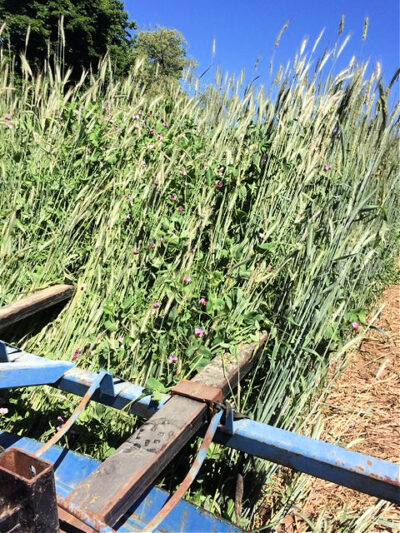
Roller crimper, then coulter with an old fertilizer knife behind, to make planting easier.
Nitrogen (N) is a slippery, shape-shifting nutrient. As a critical part of amino acids, the building blocks of protein, an adequate supply of N is critical for plant health, yield and quality. It is also the most limiting factor for plant growth in many agricultural soils. Maintaining an adequate supply of N to growing crops often makes the difference between success and failure. But N is a classic example of the truth that more of a good thing is not necessarily better. The difference between enough and too much can be slight and N turns from an asset to a liability, causing problems for crops, soil, farmers’ bank accounts and the environment. In this article we will explore how N becomes available to plants, and how, when necessary, we can supplement our crops in an efficient and responsible way.
At its core, the N cycle is biological. Each chemical transformation that N undergoes is catalyzed by soil organisms who, depending on their needs and the conditions in the soil environment use N in its different forms. They use N to synthesize amino acids, as an energy source, or even as a final electron receptor in anoxic soils, much as we use oxygen in our own respiration. It is important to remember that microbes, plants and animals were participating in the N cycle for hundreds of millions of years before the fertilizer bag was filled.
The Nitrogen Cycle: A quick recap of the N cycle: N2 gas in the atmosphere is “fixed” into biologically available ammonia by microbes (free living, or in association with plants like legumes) or the Haber-Bosch process (to make chemical fertilizer). When chemical fertilizer or animal manure is applied to soil, or microbes decompose plant matter and themselves excrete waste products, ammonia is released into the soil (ammonification). Depending on conditions, some ammonia is lost to the air (volatilization). Ammonia is converted to ammonium, NH4+ in the soil. Plants can utilize NH4+. Because it is positively charged (and so is a cation), it can be held by the soil’s cation exchange capacity. If the soil is aerobic, certain bacteria can use NH4+ as an energy source by converting it to nitrate, NO3- (nitrification). Nitrate is also used by plants as an N source. Because it is negatively charged, NO3- is not held by the soil’s cation exchange capacity and can leach out of the soil more easily than NH4+. In addition to being lost to plants, nitrate leaching is a serious environmental problem, leading to the contamination of groundwater and the pollution of rivers and other bodies of water. In the anaerobic parts of soil aggregates, or if the soil becomes saturated and anaerobic, another group of bacteria use nitrate as an oxidizer or final electron receptor in their metabolism. Essentially, they breathe nitrate. This process is called denitrification, and occurs stepwise, stripping off oxygen atoms from the nitrate (denitrification). NO3- to NO2- to NO to N2O to N2, which is atmospheric nitrogen gas, and the cycle can begin again. Unfortunately, in addition to denitrification being a loss of N as a fertility source, some N2O, also known as nitrous oxide or laughing gas, escapes to the atmosphere, where it is hundreds of times more potent a greenhouse gas than CO2.
 The take home message of the nitrogen cycle is that it is leaky. Volatilization, leaching and denitrification are all ways that N that you paid for doesn’t end up in your crops. Instead, ammonia in the air stinks up the neighborhood, nitrate poisons your well and nitrous oxide contributes to climate change. It is in all of our best interest to tighten up the nitrogen cycle.
The take home message of the nitrogen cycle is that it is leaky. Volatilization, leaching and denitrification are all ways that N that you paid for doesn’t end up in your crops. Instead, ammonia in the air stinks up the neighborhood, nitrate poisons your well and nitrous oxide contributes to climate change. It is in all of our best interest to tighten up the nitrogen cycle.
Nitrogen Pools and Flows: To tighten the N cycle, we need to zoom out our perspective, and remember that soil is a biologically, not chemically driven system. The concept of “pools and flows” is useful here. Most of the N in a healthy soil isn’t in any of the forms mentioned in the previous paragraphs. Soil organic matter (SOM) and living things (biomass) contain N, and are important pools of N in the soil. The N in the SOM and biomass pools is carbon-bound, incorporated into living and formerly living organisms. Organic (carbon bound) N doesn’t leach, volatilize, or denitrify. It is largely safe from the vicissitudes of rainstorms and cold wet springs.
The paradox is, of course, that with the exception of some cases where mycorrhizal fungi feed plants ready made amino acids, plants cannot directly utilize organic N. Plants are dependent on the availability of ammonium and nitrate in the soil, and yet these are the forms of N which are most vulnerable to loss and potentially damaging to the environment. N is constantly flowing from one pool to the next. Our goal as soil stewards and farmers is to manage the flow of N from the organic pool to the inorganic (mineralization) so that our crops have adequate nutrition while minimizing potential losses.
Mineralization of N occurs when soil organisms eat and produce waste. When we eat, proteins in our food are either used to build and maintain our bodies, or are broken down to provide us with energy. When this happens, our bodies need to get rid of the leftover nitrogen. Our bodies excrete N in the form of urea in our urine. When a protozoan, for instance, grazes some bacteria in the soil, it releases ammonia as waste. Biomass is never converted from one organism to another with 100% efficiency. This “loss” at each transaction is kind of like a sales tax on each transaction in the soil economy. Every time an organism eats something, some of the N contained in it is mineralized, just as every time money changes hands in our economy, a portion of it goes to taxes. Plants utilize this “inefficient” transfer of N from organism to organism in the soil ecosystem.
Immobilization: The opposite of mineralization is immobilization. If there is plenty of carbon available in the soil, and not enough nitrogen, bacteria and fungi will use inorganic N just as plants do to make amino acids. N won’t be mineralized until the carbon source is used up and N is no longer the most limiting factor. The ratio of C:N in soil has a big impact on whether there will be net immobilization or mineralization of N. An example of a scenario where immobilization might occur is when mature rye is plowed down as a cover crop. N is often immobilized for several weeks after plowdown, even though the rye contains large amounts of N. Once enough carbon in the rye straw has been eaten by microbes and oxidized to CO2, and the C:N ratio has fallen to the 30:1 range, the cover crop residue begins to mineralize N. A general rule is that a C:N ratio of over 30:1 will result in N immobilization and the lower the C:N ratio of an amendment, the faster the N contained in it will be mineralized.
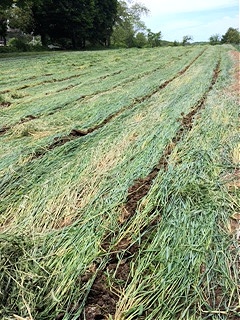
Field after rolling and crimping.
The rate of N mineralization over the course of a growing season is dependent on several factors. Temperature, oxygen, biological activity, moisture and C:N ratio of cover crops and amendments all influence how much N will become available to plants, and when. Typically, soils start the growing season cold and wet. Biological activity is low, and N mineralization is low. As soil warms, mineralization increases through the growing season, and peaks in early fall. Tillage, black plastic mulch and consistent water all increase mineralization. Tillage increases N mineralization by increasing oxygen and making organic matter more available for decomposition. Black plastic mulch increases N mineralization by increasing the temperature and thus growth rate of soil organisms, and because N mineralization is biological, and water is necessary for life, consistent water is necessary for mineralization. Conversely, compaction (low oxygen), light colored mulch on cold soil, drought, and incorporation of high C:N materials (wood shaving-rich manure, mature ryes, etc.) reduce mineralization.
Nitrogen Budgeting: To determine how much (if any) N containing amendments are needed to grow a crop, you first need to know how much N your crop needs, and how much N your soil is likely to mineralize both over the course of the growing season, and whether the N your soil provides will be available when your crop needs it. I like to use the New England Vegetable Management guide, produced by Cooperative Extension (nevegetable.org/crops) to get a rough sense of how much N I should expect my crops to need. Generally, I find their recommendations to be on the high side, but it’s a useful starting point nonetheless, and is a great resource for other cultural practices. Say, for instance that you want to grow some fall cabbage. The Vegetable Management guide suggests up to 160 lb N/acre. I think the cabbage would be fine if less N was available, especially if aphids, an indicator of excess nitrate in plant tissues have been a problem in the past. A good compromise might be 120 to 150 lbs./N/acre.
Size up your organic N pools, SOM and biomass. A useful rule of thumb is that over the course of the growing season, each 1% SOM in your soil will release 10 lbs. N/acre. Some sources place this rule of thumb closer to 20 lbs./N/acre. If your soil has 5% organic matter, and you are planting when the soil is warm, give yourself a credit of 50 to 75 lbs./N/acre.
How much N will come from your cover crop? Another rough rule of thumb is that with 100% soil coverage, the first 6 inches of cover crop growth equals 2000 lbs./acre of dry biomass. Each additional inch is another 150 lbs. of biomass/acre. For a cover crop like rye, which sends up skinny stalks, reduce this number a bit.
Legumes contain 2.5 to 3.5% N by dry weight. Before flowering, use the higher number, after flowering, use the smaller one. Non legumes, such as rye, are 2 to 3% N when vegetative early in the season, and 1.5% or less after flowering. Keep in mind that a mature grass cover crop with low N will cause immobilization for a time after incorporation.
So, if you have 8 inches of red clover growing in your field, figure 2300 lbs./acre dry biomass. It is just beginning to flower, so figure 3% N. 2300lb/acre biomass X 0.03 = 69lb N/acre. Round up to 70 lbs. N/acre.
If tillage is used, most of the N in the cover crop will be mineralized the first season. If you are plowing the clover, figure 75% of the N will become available, for a N credit of 52.5 (round to 50) lbs. N/acre. If you are solarizing the clover to kill it, and leaving the residue on top, less N will become available, depending on moisture, how active soil biology is, etc.
The fuzzy bottom line of N budgeting: Your cabbage crop needs 120 to 150 lbs. N/acre. We predict that SOM will provide at least 50 lbs. N/acre, and that the cover crop will provide at least another 50. The crop’s needs fall within the margin of error of our predicted N supply in your field. It’s up to you if you would like to add more N. If the cover crop was plowed immediately before planting, it may be wise to add some extra N. If it has been a very wet growing season, adding N to offset leaching may be helpful.
20 to 30 lbs. N/acre may be helpful, especially if high yields are a goal, and other nutrients, water, and soil texture are not limiting factors.
Converting to a smaller scale: Most of us are not planting whole acres of specific crops. To convert these figures to a smaller area, there are 43,560 square feet in an acre. Divide the area of your planting by 43,560 to get the area in acres, then multiply the rate of fertilizer/acre by this number to find the total pound of amendment needed.
So, if your cabbage planting is 20 by 75, that is 1500 square feet.
- 1500 ft2/43560 ft2/acre = 0.0344 acres.
- 250 lb. peanut meal x 0.0344 = 8.6 lbs. peanut meal will provide 20 lb. N/acre in your planting of cabbage.
This fertilizer could be applied at planting, or as a side dress at one of the cultivations. Side dressing allows you to correct a deficiency mid-season and avoid over application of fertilizer at the beginning of the growing season.
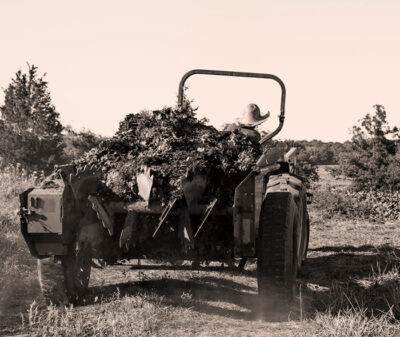
Photo by Paul Carey Goldberg
Quantitative options: To be more quantitative, a pre-side dress nitrate test, or PSNT can be used to determine if there is enough nitrate present in the soil for the crop to complete its growth. These tests are available from the Land Grant Universities. I’ve found them to be useful when trouble shooting why plants look light colored and hungry. I avoided an unnecessary application of N a few seasons ago by sending out a test after weeks of wet weather. My plants looked hungry, but there was plenty of nitrate in the soil. They greened up once the sun came out. A downside of PSNT is that it can show a deficiency of N in a very biologically active organic soil. If N is being mineralized and used very efficiently by plants and other organisms, little inorganic N may be present at a given time, even though there is plenty getting into the plants, and plenty more that will be mineralized from the soil.
Hang on to that N! As the days shorten, the air cools and your crop nears maturity, its daily N needs decrease. Soil temperature lags behind air, and N continues to be mineralized well into the fall. If there is space between the cabbage plants, plant a cover crop in the pathways such as winter rye or oats. If you are able to harvest before October 15, mow the cabbage plants and get a crop of rye established to sop up excess N. There will be that much more N credit in your budget next season.
Why is this process so imprecise?
Nitrogen is a moving target. Every soil in every season is different. The amendments you added last season might continue to mineralize this season. A heavy rain may wash much of the nitrate out of your soil. If your soil becomes very dry, mineralization of N stops. Soil is not an inert medium for holding plants upright and holding the chemicals we feed them. It is a biological system with too many interconnected variables to use rigid predictions. Instead, use your powers of observation and logic.
Spend some time with your plants. Not working. Real, quality time. Talk to them if you want. Or sing. Seriously, though, you will know if your plants have what they need if you watch and listen to them.
If they look light colored, or stressed, before reaching for the fertilizer bag, ask yourself why they might look that way. How has the weather been? If it’s been dry, that can cause the soil to stop providing N. Ditto for wet weather. Has it been cold? No tomato transplant will look dark green if it is chilled, regardless of what you put in the soil. Check out the roots of the plant. Are insects or disease present?
Too much N can be a problem, too, especially when dry soil prevents N from being converted effectively to protein. Aphids and other pests can quickly become problematic on many crops. Deep green color without fast growth is an indicator that this is happening.
As organic growers, we recognize that an understanding of how N works in the soil and environment is a powerful tool as we strive to make our farms and gardens more profitable, equitable and regenerative. Organic agriculture stands at the intersection of science and artistry as we use our senses to adapt and work with the weather, soil ecosystem and plants to responsibly feed our communities.

